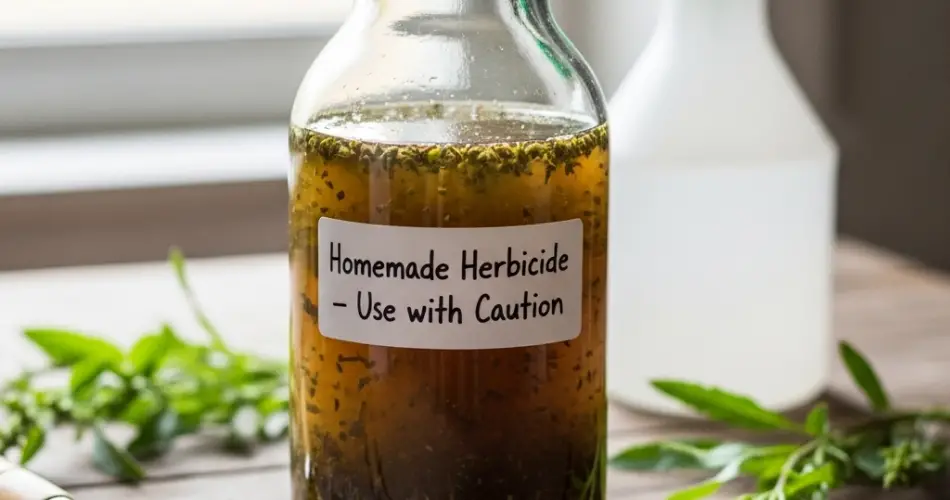Weeds can quickly take over a garden, stealing nutrients, water, and sunlight from the plants you actually want to grow. While commercial herbicides are commonly used, they often contain harsh chemicals that can harm the environment, pets, and even your crops. Fortunately, there’s a simple, safe, and effective alternative: a homemade herbicide made from everyday household ingredients.
This DIY solution targets unwanted weeds without damaging the rest of your garden, making it ideal for urban gardens, home vegetable patches, and eco-conscious gardeners. Here’s how to make and use this natural herbicide and take control of your outdoor space—without synthetic chemicals.
Why Use a Homemade Herbicide?
Commercial herbicides may be effective, but they often contain glyphosate and other synthetic compounds that can contaminate soil, harm pollinators, and affect beneficial insects and microorganisms. Over time, this can degrade soil health and disrupt your garden’s ecosystem.
A homemade herbicide offers a natural, biodegradable, and non-toxic solution to weed problems. It’s affordable, easy to make, and just as efficient when used properly.
Ingredients You’ll Need
This homemade herbicide relies on a combination of household items that most people already have in their kitchen. The main ingredients work by drying out and disrupting the growth of weeds.
Basic formula:
-
1 liter of white vinegar (at least 5% acetic acid)
-
2 tablespoons of salt (table salt or rock salt)
-
1 tablespoon of dish soap (biodegradable, non-scented if possible)
These ingredients each play a role:
-
Vinegar acts as a natural desiccant, drying out plant tissues.
-
Salt disrupts the plant’s internal water balance and inhibits regrowth.
-
Dish soap helps the solution stick to the plant leaves, increasing its effectiveness.
How to Prepare the Herbicide
-
In a large spray bottle or garden sprayer, pour in 1 liter of white vinegar.
-
Add 2 tablespoons of salt, stirring well to dissolve completely.
-
Mix in 1 tablespoon of dish soap and stir gently to avoid excessive foam.
-
Shake or mix the contents thoroughly before each use.
Store the solution in a cool, dry place. Use it within a few days for best results, as vinegar can lose potency when exposed to air for too long.
How to Apply the Herbicide
This homemade herbicide works best on sunny, dry days when the temperature is above 20°C (68°F). Sunlight helps accelerate the drying process, increasing the herbicidal effect.
Instructions:
-
Identify the unwanted weeds in your garden or between pavers and cracks.
-
Shake the spray bottle to ensure even mixing.
-
Spray the herbicide directly on the leaves and base of the weeds. Avoid overspray on nearby plants you want to keep.
-
Wait and monitor over the next 24–48 hours. Most weeds will start wilting and browning within a day.
For particularly stubborn or deep-rooted weeds, a second application may be necessary.
Where to Use It Safely
This natural herbicide is great for:
-
Garden paths
-
Between paving stones
-
Along fences
-
Edges of raised beds
-
Driveways or patios
However, avoid spraying it near edible plants, seedlings, or areas where you plan to sow seeds, as vinegar and salt can alter soil pH and inhibit germination for a short time.
Important Tips and Warnings
-
Use selectively. This solution is non-discriminatory and will harm any plant it touches. Be precise when spraying around crops or flowers.
-
Do not overuse salt. Excess salt can build up in the soil and cause long-term fertility issues. Limit usage to isolated areas or weeds growing in cracks or hardscape.
-
Test in a small area first. Especially on patios or decorative surfaces, to ensure no discoloration or surface damage occurs.
Long-Term Weed Prevention
While this herbicide is effective, prevention is just as important for long-term garden health. Here are some natural tips to keep weeds from returning:
-
Mulch heavily: Use straw, bark chips, or shredded leaves to suppress weed growth and retain moisture.
-
Densely plant crops: The more space your garden plants occupy, the less room weeds have to grow.
-
Hand-pull regularly: Especially before weeds flower and produce seeds.
-
Use ground covers: Low-growing plants like clover can compete with weeds and protect the soil.
Final Thoughts
Tackling weeds doesn’t have to involve harmful chemicals or expensive store-bought solutions. With just vinegar, salt, and dish soap, you can create a highly effective herbicide that’s safe for you, your family, and the environment.
Perfect for urban gardens, home growers, and eco-friendly households, this natural weed killer is an easy way to maintain a clean and productive growing space. Try it once, and you may never go back to commercial weed control again.



